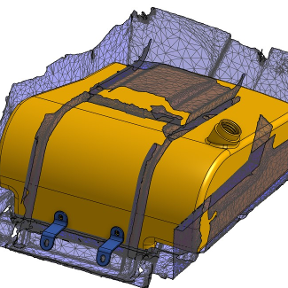Welcome to the Onshape forum! Ask questions and join in the discussions about everything Onshape.
First time visiting? Here are some places to start:- Looking for a certain topic? Check out the categories filter or use Search (upper right).
- Need support? Ask a question to our Community Support category.
- Please submit support tickets for bugs but you can request improvements in the Product Feedback category.
- Be respectful, on topic and if you see a problem, Flag it.
If you would like to contact our Community Manager personally, feel free to send a private message or an email.
Best Of
Re: Troubleshooting procedure for fillet failure (and any other failed feature, for that matter)
I have a experienced some issues recently with mirrored geometry not behaving the same as the "original" side, specifically when working with fillets (and drafts). My guess would be that the software uses the "context" provided by the feature creation before the fillet to figure out how to apply the fillet but that gets lost on the "mirrored" side, or something along these lines but you would think the mirrored geometry would work the same!
A couple tricks for troubleshooting fillets:
- The first step is to try a smaller fillet radius to see what happens, sometimes the value at which it fails will match another fillet or feature size that can provide a hint on what's going on. Depending on the issue (and the design intent), a variable fillet can help with these cases
- Temporarily turn off "tangent propagation" and investigating what happens around the trouble area and when manually selecting things can also provide insight
- You can also play with the "edges to keep" under the "allow edge overflow" box (although probably not relevant in this case)
Re: Export/import of Featurescript for a Part Studio?
A simple example is renaming. You can change the name of a variable with a text editor that supports multifile search and replace (with Emacs as an early example). This is not a single-step operation, as local and member variables may use the same names (in effect, false positives).
You can avoid the problem somewhat with naming conventions. I am starting to drift toward using a version of Hungarian notion for my CAD parameters.
You can do most any sort of transformation in a smart text editor, especially with well-chosen naming, though the process may be rather manual. Learned that lesson a *long* time ago.
https://bannister.us/weblog/2005/structure-editors-ides-and-another-lisp-flashback
Yes, clearly if I had chosen good names for my parameters up front, I would not be looking to rename my parameters later. This is much like the experience with top-down versus iterative (agile) design in software.
Interesting ... I discovered the Featurescript view is live. If I select items in the "Features" view, then the corresponding text is highlighted in the script view (very cool). As a hack, I created a variable with the desired name, updated the existing variable to reference the new name, then suppressed the variable (in hopes of discovering where it was used, for manual fix-up).
First, the interface showed the "wait" cursor for rather a long time. As a non-paying user, I feel a bit guilty if I am slamming one of the Onshape servers.
Second, what failed was one of the sketches, which in my case was ~700 lines of Featurescript code. As the "Features" tree is a single level, in practical terms this is far too crude for figuring out what items in the sketch needs fixing.
Which means doing renaming in a text editor is still a better idea.
Note that this mapping between empirical language and visual representation is an old topic in programming environments. In roughly historic order, Visual Basic, Visual Cafe, Visual Studio, NetBeans, and (sometimes) Eclipse all had/have support.
As to whether there is need for this level of support in the CAD world, I have no clue.
Re: best way for loft sections between two changing size faces in different parts
it's hard to tell from your image but is this spherical or cylindrical? or neither? if possible can you share a link to what you have so far?
 MDesign
MDesign
Re: Thickness analysis.
if you're on the standard plan, sadly this is not available. :-( (i.m.h.o. it should be, this is standard CAD analsysis stuff). In that case there's a custom feature by @MichaelPascoe :
https://cad.onshape.com/documents/55e98155dca4ba4e8049a18d/w/dbf02fb86aafef13f08be126/e/67100c66e805cdf37822750a?renderMode=0&tangentEdgeStyle=1&uiState=684ff1f95854d0479d7932da
Re: Using partQuery in FeatureScript to retrieve parts
I recommend the first approch. Here's a public document that shows how the feature can work: https://cad.onshape.com/documents/0f85058bb5f40b8535a4f8de/w/7daa1dc09bec441651d39f8d/e/0637ea3ac59e4d5f24be41b1
To answer your question, on the FS side, the query is just a query. For work with the API, Onshape exposes the query as a partId.
New Feature: Better Than Boolean
Coming to Onshape from Solidworks and Fusion 360 there was a gap in the feature set that I was missing from both of these tools. In Solidworks the feature was called Intersect and in Fusion the feature is called Boundary Fill. In each of these softwares the feature does basically the same thing, which is enable disgustingly lazy modeling practices where you can kitbash parts together keeping the functional bits of part A and part B and discard the leftovers in one go. I couldn't go on living without this jackhammer of a tool in my belt so I went ahead and developed my own implementation in Featurescript. I present to you: Better Than Boolean.
It works by decomposing input bodies into their overlapping regions and allows you to select which chunks of Venn Diagrammed part you'd like to reconstitute into a single manifold body, throwing away the rest.
Okay that's not that impressive, you could do that by selecting regions of sketch and just not extruding the bits you didn't want. But what if you wanted to make a manifold body?
For example let's say I want to 3d print a garden hose manifold and I wanted not to waste time modeling threads. Of course I'd derive a single part into a studio to simplify the modeling process. But I'd also have to define a cutting tool to remove geometry for the water to pass through, and I'd have to trim parts off of my tool body to make sure the internal bits don't interfere with each other or the manifold body. That's a lot of work, and I'm lazy.
Before:
After:
Now if you're familiar with either of those implementations of tools I mentioned before you'll be aware that they also allow enclosing of regions via planes and surfaces. This is not yet supported by this tool, but is something I might add in the future. Would probably require a complete refactor of the decomposition logic which is currently being done purely by bounding box checks, evCollision, and a whole mess of boolean operations under the hood. I'm putting this out there in the current state because my core use-case is greebling parts together and not surfacing operations. One day when I figure out how to do a plane sweep algorithm I might rework the core logic under the hood to add the surface and plane functionality.
Re: Sketches: Equal offsets
There are a bunch of improvement requests around things like this.
I'm guessing since you can create a variable on the fly while in sketcher, and you can modify them in sketcher, Onshape isn't going to change things any time soon. It would be nice to have equals constraints work in more situations.
 S1mon
S1mon








